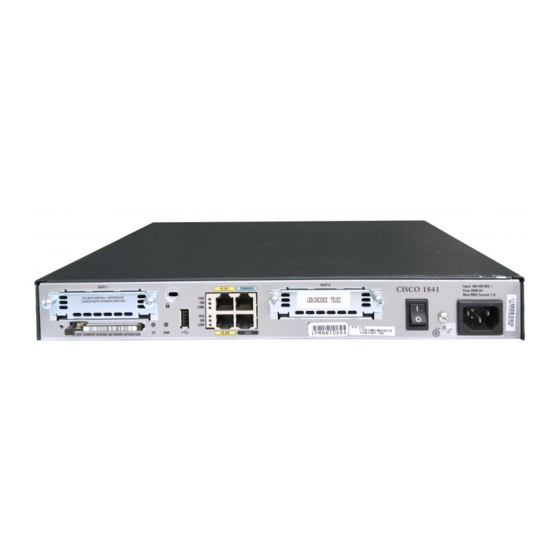- ページ 7
ネットワーク・ルーター Cisco 1861 SeriesのPDF データシートをオンラインで閲覧またはダウンロードできます。Cisco 1861 Series 20 ページ。 1800 series
Cisco 1861 Series にも: ユーザーマニュアル (9 ページ)

SIP
MGCP
Y
Y
N
Y
N
Y
Y
Y
Y
Y
Y
N
Y
Y
Y
Y
Y
Y
Y
N
-
-
Y
-
Y
Y
Y
N
Y
N
Y
N
N
Y
8
Requires Cisco IOS Software Release 12.4(20)T or later
9
Requires Cisco Unified Communications Manager 4.2(3)
10
G.722 is not supported with MGCP. G.722 requires Cisco IOS Software Release 12.4(20)T or later with Cisco Unified
Communications Manager 5.0 or later. iLBC requires Cisco IOS Software Release 12.4(15)T or later with Cisco Unified
Communications Manager 6.0 or later
© 2013 Cisco and/or its affiliates. All rights reserved. This document is Cisco Public Information.
H.323
Feature
Y
Caller ID support
Y
Malicious caller ID (MCID) over PRI
N
Multilevel precedence and preemption (MLPP) for T1-PRI
(backhaul) and T1-CAS (wink start only)
Y
Group III fax support
9
Y
T.38 standards-based fax support
Y
Private-line automatic ringdown (PLAR)
Y
Standards-based codecs
Y
Voice activity detection (VAD)
Y
Comfort-noise generation
Y
Busy out
Y
H.323 ITU Version 1, 2, 3, and 4 support
-
SIP IETF RFC 3261 support
Y
Authentication, authorization, and accounting (AAA)
Y
IVR support
Y
Automated Attendant
Y
VoiceXML
7
Y
Overlap sending over voice over IP (VoIP)
8
10
Benefits
This feature helps the unified communications router
send the caller ID of a caller for display:
In MGCP mode, to and from IP phone, FXS, T1/E1 PRI;
and FXO to IP phone, not conversely (caller ID currently
not supported on T1-CAS).
In SIP and H.323 mode, to and from IP phone, FXS, BRI,
T1/E1 PRI; and from FXO to IP phone, FXS, BRI, and
T1/E1 PRI, not conversely.
MCID over PRI facilitates malicious call notification to on-
net personnel, flags the on-net call detail record (CDR),
and notifies the off-net (PSTN) system (through the
network interface) of the malicious nature of the call.
This feature helps assure high-ranking personnel
communication to critical organizations and personnel
during network stress situations. It allows priority calls for
validated users to preempt lower-priority calls.
Group III fax support facilitates transmit of Group III faxes
between the PSTN and IP using either fax relay or fax
pass-through methods.
This feature enables transmit T.38 fax between the PSTN
and IP.
PLAR provides a dedicated connection to another
extension or an attendant.
You can choose to transmit voice across your network as
either uncompressed pulse code modulation (PCM) or
compressed from 5.3 to 64 kbps using standards-based
compression algorithms (G.711, G.729, G.729a/b, G.722,
Internet Low Bitrate Codec [iLBC], G.723.1, G.726, or
G.728).
VAD conserves bandwidth during a call when there is no
active voice traffic to send.
While using VAD, the digital signal processor (DSP) at
the destination end emulates background noise from the
source side, preventing the perception that a call is
disconnected.
When the WAN or LAN connection to the router is down
or network conditions are such that a call cannot be
admitted, this feature will "busy out" the trunk to the PBX
or PSTN.
These versions of H.323 use industry-standard signaling
protocols for setting up calls between gateways,
gatekeepers, and H.323 endpoints.
This feature uses industry-standard signaling protocols
for setting up calls between gateways and SIP proxies or
SIP Back-to-Back User Agents.
AAA supports debit card and credit card (prepaid and
postpaid calling card) applications.
IVR offers Automated-Attendant support, voicemail
support, or call routing based on service desired.
This feature uses IVR to provide automated call-
answering and -forwarding services.
VoiceXML controls calls "in queue" at the gateway for
call-center applications. Calls are redirected only when an
agent becomes available.
This feature speeds variable-length dial strings dialing.
Page 7 of 20
